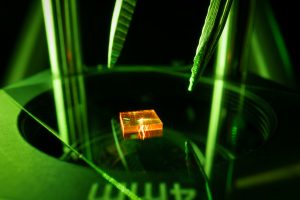The fact that chemists like diamonds has little to do with the fact that they are precious gemstones. As an unspectacular variant measuring only four square millimeters, diamonds can be used as a highly sensitive quantum-based sensor element. This gives scientists detailed insights into the atomic and molecular world at interfaces. A group of researchers from the Cluster of Excellence e-conversion has now shown that the type of the surrounding electrolyte has a sensitive influence on measurements.

Sensitive diamond: With the help of laser light and a specially prepared diamond measuring four square millimeters, the TUM researchers can analyze even the smallest amounts of material. (Photo: Christoph Hohmann / MCQST)
Sensors work in secret – and are still present everywhere and, above all, useful: from the heart rate monitor in the watch to the car airbag to the smartphone. The task of the sensor is to convert a physical signal into a measured value. This can then be processed further and, for example, causes the airbag to unfold in the event of a crash. “In the case of quantum sensing technology, we are moving to the scale of atoms and molecules. We use a four-square-millimeter diamond as a sensor, on which we can analyze the smallest amounts of substances,” says Fabian Freire-Moschovitis, a chemist and doctoral student in the research group of Prof. Dominik Bucher at the Technical University of Munich (TUM). “Our goal is to achieve chemical resolution at the nanoscale.” The research team intends to use it, for example, to study the metabolic processes of individual cells. The technique makes it possible, for example, to observe biomolecules directly and with atomic precision in the living environment or to analyze catalytically active substances in detail. Freire-Moschovitis has now shown that the surronding medium – in this case the electrolyte – sensitively influences quantum sensing measurements.
Magnetic sensing in the nano cosmos
How quantum sensing works can be explained in simplified terms as follows: Electrons circulate around every atomic nucleus, and they also rotate around themselves like a spinning top. They have a so-called spin, which causes a magnetic dipole to form around the electron. This behaves like a tiny magnet repelled or attracted by other magnetic fields. “We use this effect with our diamond sensor. However, it has to be specially designed for this purpose: In its carbon lattice, one C atom is replaced by a nitrogen atom (N), and another adjacent C atom is replaced by a vacancy (V). Together they form the so-called nitrogen-vacancy (NV) center, which has an electronic structure and a spin, similar to an atom. The special feature of our sensor is that we can optically read out its two states, spin up and spin down, by their different fluorescence intensity,” explains Freire-Moschovitis. The TUM researcher uses an ensemble of NV centers located 5-10 nanometers below the diamond surface. These NV centers act like a compass needle: they sense magnetic fields in their environment and translate them into an optically readable fluorescence. To do this, a green laser beam is directed at the diamond. This absorbs a part of the light; another part is re-emitted – the latter can be measured as red fluorescence. If a substance is applied to the surface, the intensity of the fluorescence changes. Even the magnetic field of a few molecules is sufficient to detect a signal.
This is how the spin lifetime of the quantum sensor goes into extra time
Electrolytes, used in many biochemical and electrochemical systems, also affect the diamond quantum sensor, Freire-Moschovitis describes in a paper that recently appeared in the journal ACS Nano. “That paramagnetic substances, such as manganese or gadolinium chloride, shorten the quantum sensor’s spin lifetime (or T1 time) is already well-known. We have now found that diamagnetic electrolytes such as sodium or lithium chloride, on the other hand, extend this lifetime. This makes them measurable,” explains the TUM chemist. “So you have to consider this effect for quantum sensing measurements in electrolytic environments where both para- and diamagnetic species may coexist – otherwise, the results will be misleading.” For users, this is important information. The TUM researcher’s results could be a first step toward electrolyte detection at the electrode interface. “So far, very few methods exist to characterize the electrochemical double layer. But this is exactly where the transformation processes occur- whether in capacitors, catalysts, or electrodes,” says Freire-Moschovitis. As a kind of magnetic magnifying glass for the nanoworld, quantum sensor technology can make a valuable contribution to making the hidden more visible. (Author: Caroline Zörlein, e-conversion)
Publication:
The Role of Electrolytes in the Relaxation of Near-Surface Spin Defects in Diamond. Fabian A. Freire-Moschovitis, Roberto Rizzato, Anton Pershin, Moritz R. Schepp, Robin D. Allert, Lina M. Todenhagen, Martin S. Brandt, Adam Gali, and Dominik B. Bucher, ACS Nano 2023 https://pubs.acs.org/doi/10.1021/acsnano.3c01298
Contact:
Fabian Freire-Moschovitis
Quantum Sensing
Technische Universität München
Mail: fabian.freire@tum.de
Prof. Dr. Dominik Bucher
Quantum Sensing
Technische Universität München
Mail: dominik.bucher@tum.de
